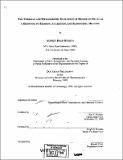The thermal and metamorphic evolution of mountain belts as a response to erosion, accretion, and radiogenic heating
Author(s)
Huerta Audrey Dean, 1960-
DownloadFull printable version (18.71Mb)
Other Contributors
Massachusetts Institute of Technology. Dept. of Earth, Atmospheric, and Planetary Sciences.
Advisor
Kip V. Hodges and Leigh H. Royden.
Terms of use
Metadata
Show full item recordAbstract
Simple thermal models of collisional orogenesis generally predict metamorphic temperatures that are much cooler than those revealed by thermo barometric studies of real metamorphic terrains. This thesis focuses on a more realistic model that accounts for the redistribution of crust enriched in heat-producing elements by accretion and erosion. In collisional settings, these processes lead to the development and growth of a wedge of heat producing crust within the overriding plate. Maximum temperatures in an orogenic setting occur within this wedge, and inverted thermal gradients occur beneath the zone of maximum temperatures, a characteristic not displayed by simple models that ignore the combined effects of accretion and erosion. Synthetic metamorphic field gradients generated by tracking the pressure temperature history of rocks advected through a model orogen are generally similar to those observed in the field. Specific aspects of these metamorphic patterns can be related to the relative rates of accretion, erosion, and plate convergence. In particular, peak metamorphic temperatures within the core of an orogen are related to ratios of accretion rate to convergence velocity; and the distance from the toe of an orogen to the metamorphic core is controlled by the ratio of erosion rate to accretion rate. In addition, results of this model challenge two prevailing paradigms in metamorphic petrology: 1) that the metamorphic record does not closely reflect the geothermal gradients within an orogen; and 2) that metamorphic pressure-temperature paths characterized by isothermal decompression require rapid un roofing. Under special (but nonetheless realistic) conditions, metamorphic field gradients closely mimic actual geotherms. The model predicts that pressure-temperature paths for rocks from the metamorphic cores of mountain ranges will display a component of isothermal decompression, even at low exhumation rates. The sensitivity of the metamorphic history of a synthetic collisional orogen to the rate and geometry of accretionary and erosional processes implies that it should be possible to use the metamorphic record of a real orogen to extract information about rates of deformation and denudation. Tests of this hypothesis with data from the Himalayan orogen confirm that most critical parameters can be constrained to within about 30%.
Description
Thesis (Ph.D.)--Massachusetts Institute of Technology, Dept. of Earth, Atmospheric, and Planetary Sciences, February 1999. Includes bibliographical references.
Date issued
1999Department
Massachusetts Institute of Technology. Department of Earth, Atmospheric, and Planetary SciencesPublisher
Massachusetts Institute of Technology
Keywords
Earth, Atmospheric, and Planetary Sciences.